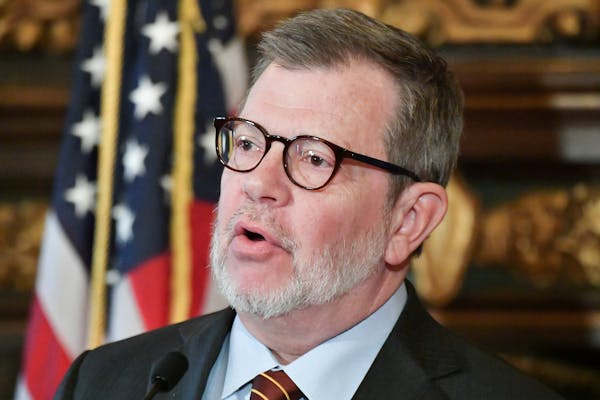The University of Minnesota could be poised to hire its first female or minority top leader as the search for a president enters the final stretch.
The university's search committee announced Friday that it interviewed nine contenders for the job out of a total of 67 applicants. Women made up roughly a fifth of the application pool, but five of the nine who scored an interview were female. A third of those interviewees were people of color, compared with 25 percent among all 67 applicants.
The committee then narrowed down the list further, though the U would not say how many candidates made that shortlist or disclose information about their demographics. The U's search consultants are vetting these front-runners before their names are passed on to the governing board.
Faculty and others had called on the U to release demographic data on the applicant pool to reassure the campuses that the university is in a position to at least strongly consider women and applicants of color for the presidency, which white men have held exclusively since the U's founding in 1851.
"I found it very encouraging that the search committee took diversity seriously," said Joseph Konstan, the head of the faculty senate.
The university did not provide additional information on the applicants' qualifications or experience, except to say that they come "from a variety of backgrounds." When the U last set out to recruit a president in 2010, its job description called for a leader with experience in academia, but this time around regents have suggested they're more open to nontraditional candidates. Eric Kaler, who was among 150 candidates for the job in 2010, is stepping down next summer.
Nationally, the college and university presidency remains a job largely held by white men. But in Minnesota, the State Colleges and Universities system and private nonprofit campuses have made headway in recruiting female presidents and, to a lesser extent, leaders of color in recent years. The chancellors at three of the U's four greater Minnesota campuses are women, all of them appointed last year.
The U said its search committee chose "a smaller number" of candidates for closer vetting, which will include checking their credentials and references and reviewing their credit history as well as conducting civil, criminal and DMV background checks. Later this month or in early December, the committee is slated to recommend three or four applicants to the full Board of Regents. Once regents choose finalists to interview on campus, their names will become public.
Nationally, less than a third of campus presidents are women and less than a fifth are minorities, according to last year's American College President Study from the American Council on Education. Those percentages inched up only slightly from the council's previous survey in 2011. About 15 percent came from outside higher education circles.
In contrast, half of the Minnesota State system's 30 university and college presidencies are now held by women, including six female leaders of color. Overall, a third of system presidents as well as its chancellor, Devinder Malhotra, who is of Indian descent, are people of color.
The demographic shift at the top of the system has come amid a concerted push to enlist more diverse leaders, said Susan Appelquist, the interim vice chancellor of human resources.
"The committees and consultants who conduct searches for our college and university presidents understand this commitment, and this helps them build diverse and excellent candidate pools from which to choose," she said.
The system has also redoubled efforts to cultivate its own pool of diverse top administrators; more than 40 percent of its presidents were promoted to the top job from within.
Seven of the 17 members of the Minnesota Private College Council are women, including several who became the first female presidents at their institutions in the past five years. Two of these leaders, Fayneese Miller at Hamline University and Mary Hinton at the College of St. Benedict, are black — the only presidents of color in the private campus network.
At the University of Minnesota, almost a third of undergraduates are minorities and slightly more than half are women.
Michael Hsu, a U regent who does not serve on the search committee, said he wants the university to bring in the best person for the job regardless of race and gender.
"I've heard people say, 'We have to have a woman this time,' or 'We have to have a nonwhite person this time,' " he said. "I am really not in favor of diversity for diversity's sake."
Hsu said a larger concern for him is having a competitive slate of front-runners to choose from — even if some leading contenders drop out near the finish line. In 2010, the board faced criticism for only naming Kaler as a finalist, which faculty and others said denied the campus community and the public a chance to vet and debate the merits of several leading contenders.
"My biggest fear is a sole finalist situation," Hsu said.
Konstan said the diversity of the applicant pool has been the focus of much discussion among faculty. Professors have also told the board they want to see a president with some work experience in academia who would build on the Kaler administration's efforts.
"Diversity is the No. 1 or No. 2 issue that people have raised," he said. "Some people have said they would be very unhappy if we ended up with another white male president."
Still, he added, "In the end we are not hiring a gender or a color. We're hiring a person."
Mila Koumpilova • 612-673-4781

Minnesota State Patrol celebrates diverse new class of troopers

Fired Mpls. teacher accuses management of 'cancerous rot'

Jill Biden rallies women, teachers for the Biden-Harris ticket in Bloomington speeches
Neighbors, city officials at odds over Rochester lake dam

